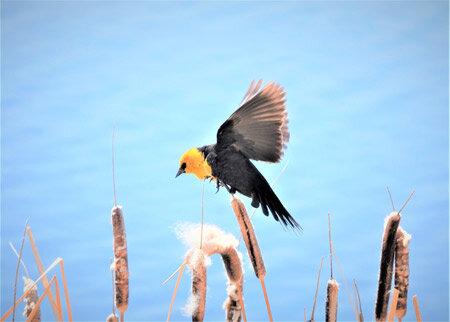
A yellow-headed blackbird in flight. Photo courtesy Randy McCormick
By Josh Pike | Pagosa Wetland Partners
One of the greatest risks that birds face from human habitations is the risk of strikes against windows and transparent surfaces. Research suggests that an estimated 1 billion birds a year die from such collisions in the United States.
The problem is especially severe during the quickly approaching spring migratory season, which brings large numbers of traveling birds through potentially hazardous human neighborhoods.
This article examines the causes behind bird strikes and looks at some of the measures you can take to “bird-proof” your home to prevent such collisions.
Bird strikes occur for different reasons during the day or night. Daytime collisions are typically caused by birds seeing the reflections of vegetation or trees in the window or seeing plants indoors. No matter the source, the vegetation the birds perceive in the window convinces them that the area where the window is actually contains desirable habitat. Believing this, they then fly into the window, expecting to land on the trees or plants they can see, and collide with the window.
Birds will also occasionally see themselves reflected in a window. Such a sighting will often lead to the bird confronting the intruder they see in the window and attempting to attack it. Although such behavior rarely leads to fatal collisions, it can be disturbing for homeowners and wastes time that the bird could otherwise spend foraging or breeding.
Nighttime collisions tend to be driven by birds seeing the lights emanating from a window. For reasons that are partially unknown, birds flying at night tend to be diverted from their courses by seeing such light and spend time circling near the light. This circling behavior can often lead to them colliding with the lighted window.
When considering how to prevent bird strikes, the first step is to determine which windows should be prioritized for strike mitigation. Large picture windows, windows placed at right angles to another window and windows near feeders are especially likely to cause bird strikes, as are windows which clearly reflect nearby vegetation.
Measures to prevent bird strikes largely focus on adding visual indicators to make the window more apparent to birds or on reducing the reflectivity of the window. The spacing of visual indicators is crucial and must be adapted depending on the type of species colliding with the window. For songbirds, indicators spaced 4 inches apart are appropriate. However, for hummingbirds, the indicators should be spaced 2 inches apart.
These indicators can take many forms. One simple method is using tempera paint or soap on the window surface. These can be applied to the windows in simple grid patterns or in artistic patterns and will allow birds to avoid the window surface. A similar effect can be achieved by placing decals, stickers or sun catchers on the window surface. There are also a range of commercial products that can be applied to windows to provide similar indicators.
Another approach is to place netting, mosquito screens or rope curtains on the outside of the windows. These objects similarly provide an indicator to birds that the window is present and deter them from flying into it.
Measures to reduce the reflectivity are similarly varied. Some of the simplest involve placing blinds or curtains on the window interiors to break up the reflections in the glass. There is also a wide variety of treatments and specially designed window glass products which make the window appear more opaque from the outside while keeping it transparent on the inside. This allows birds to easily identify the window as a solid surface while having a minimal impact on the experience of human viewers inside.
Picking what bird-strike-prevention measures are best is highly dependent on your specific circumstance and preferences. Depending on the specific circumstances and design of your home, all these measures can be effective. By implementing them, you can make your home secure for birds and reduce the impacts of your habitation on the surrounding environment. If you want more information on bird-strike protections, contact Pagosa Wetland Partners at pagosawetlands@gmail.com.